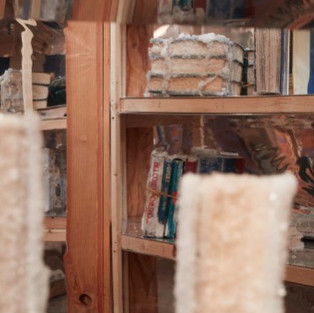
Edgar Arceneaux, Library of Black Lies at The Main Museum. Photo Courtesy of Beta Main. Photo Credit Elon Schoenholz.
Labyrinths, Libraries, and Lies
Edgar Arceneaux, Library of Black Lies
at The Main Museum
By Anna Garner
Through March 26th
Edgar Arceneaux’s Library of Black Lies has an unassuming exterior, an amalgamation of a worn out shack and an efficiently designed tiny-house. It is angular, faintly odd, and slightly dissonant from a traditional dwelling. The pinewood boards, commonly used for furniture and interior framing would decay if exposed to the elements, emphasizing a transient and mutable structure. Once inside the viewer is confronted with a labyrinth of bookshelves, multiplied by mylar wall panels that generate the disoriented feeling of a fun-house.

Edgar Arceneaux, Library of Black Lies at The Main Museum. Photo Courtesy of Beta Main. Photo Credit Elon Schoenholz.
It exists as an institution within an institution, allegorically litigating the role of that institution. As a library it is more akin to Jorge Luis Borges’ Library of Babel, than the customary public or academic library. In the Library of Black Lies unassailable knowledge is simultaneously auspicious and futile; operating in the realm of Magical Realism, the real is infused with the unreal, the fantastic and the magical.

Edgar Arceneaux, Library of Black Lies at MIT. Photo Courtesy of Beta Main. Photo Credit Elon Schoenholz.
Legible book titles include: Leo Tolstoy’s War and Peace, The New Webster Encyclopedic Dictionary of the English Language, Charles Darwin’s The Origin of the Species, and Franklin Moss’ From Slavery to Freedom. Many of these books are encrusted with crystalized sugar, obscuring the titles and blocking readership, yet another set of books are bound in a black, plastic-like material, the covers and titles completely inaccessible. Books are also physically manipulated through the simple rearrangement of letters, creating multiple adaptations of one book that again references the Borgesian library that contains books only differentiated by a few letters.
One reshuffling is Germano’s Celants Arte Povera, which becomes Jerry Cellery’s Fart Poverty. Similarly Rene Descartes’ Discourse on the Method becomes Re’re Descarte, Discourse on Meth. Through the simple chicanery of carefully rearranged letters the philosophic framework of knowledge is subverted, the canonic texts of Euro-centric academicism and art history are stripped of their undisputed positions, and the altered information becomes conceivably truer than its original.

Edgar Arceneaux, Library of Black Lies at The Main Museum. Photo Courtesy of Beta Main. Photo Credit Elon Schoenholz.
It is in these maneuverings that the liberating poetics of Magical Realism manifest, where the existence of simultaneous realities disrupt accepted cultural narratives. In a time when alternative facts are presented as real, this work is undeniably relevant; it challenges the lies that pacify the ugliness of history and the continued racism deeply rooted in American culture. In Arceneaux’s library the viewer is literally reflected, implicated in the recast, crystalized vestiges of that history. Yet it is rejected, rearranged, becoming only one version of infinite versions of truth. Within the maze-like potentials for what can be formed of the remnants the viewer is both lost and found. At its core The Library of Black Lies proclaims a regenerative uncertainty and the radical release of the entitlement to know everything.
#losangeles #california #conceptual #losangelesartist #LibraryofBlackLies #Labyrinths #art #TheMainMuseum #losangelesartmuseum #WarandPeace #FromSlaverytoFreedom #CharlesDarwin #losangelesart #contemporaryart #crystalizedsugar #book #institution #southerncalifornia #contemporary #conceptualart #bookshelves #MainMuseum #Lies #ArtePovera #BetaMain #academicism #artandcake #Libraires #JorgeLuisBorges #structure #artexhibition #installation #ArtandCakeLA #fineart #artists #EdgarArceneaux #artist #mylar #arts #AnnaGarner #artreview #books #TheOriginoftheSpecies #wood #installationart #artmuseum #LibraryofBabel #artexhibit #ArtandCulture #FranklinMoss #LeoTolstoy #MagicalRealism #arthistory #losangelesgallery #TheNewWebsterEncyclopedicDicotionary


















